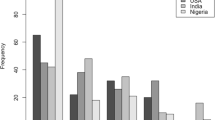Abstract
That the symbolic is an identifiable dimension of contemporary politics is unlikely to be a controversial statement. Yet, political scientists have been wary of drawing attention to the category, if not in denial about its importance for their field of study. The article starts with an overview of the public policy literature and shows how the symbolic dimension is often treated as less “real” and as “mere communication”. Despite the growing attention to feedback, narratives and qualitative approaches to the evaluation of policies, the symbolic remains a terrain treaded with care. In the second section, we propose a definition of the symbolic that highlights some of the key aspects that are relevant to political analysis and for the analysis of their role in public policy. In the third section, we advocate taking into account how public policies incorporate and use the symbolic and propose several avenues of research.
Similar content being viewed by others
Notes
See also the special issue of Political Communication (1993), 10(2).
Barker shows how some rituals are about self-legitimation (Barker 2001).
Other policies had the same objective of making “real” the existence of the Republic (citizenship education or investments in urban regeneration are two other examples).
References
Anderson, Benedict. 1991. Imagined communities: Reflections on the origin and spread of nationalism. London: Verso Books.
Austin, John L. 1975. How to do things with words. Cambridge, MA: Harvard University Press.
Balandier, Georges. 2006. Le Pouvoir Sur Scènes. Paris: Fayard.
Barker, Rodney. 2001. Legitimating identities: The self-presentations of rulers and subjects. Cambridge: Cambridge University Press.
Belot, Céline. 2012. Gouverner par les sondages? Nicolas Sarkozy et l’opinion publique. In Les politiques publiques sous Sarkozy, ed. Jacques De Maillard and Yves Surel, 71–90. Paris: Presses de Sciences Po.
Belot, Céline. 2019. Exploring the democratic linkage through the lens of governmental polling: A research agenda. French Politics 17: 211–226.
Boin, Arjen, Paul’t Hart, Erik Stern, and Bengt Sundelius. 2011. The politics of crisis management: Public leadership under pressure. Cambridge: Cambridge University Press.
Bourdieu, Pierre. 2001. Langage et pouvoir symbolique. Paris: Seuil.
Boussaguet, Laurie, and Florence Faucher. 2017a. Identity and citizenship as symbolic responses to terrorist attacks: The case of France in 2015. Percorsi Costiutionali: La Cittadinanza Incerta 2: 511–530.
Boussaguet, Laurie, and Florence Faucher. 2017b. Quand l’Etat Convoque La Rue: La Marche Républicaine Du 11 Janvier 2015. Gouvernement et Action Publique 6(2): 37–61.
Boussaguet, Laurie, and Florence Faucher. 2018. La Construction Des Discours Présidentiels Post-Attentats à l’épreuve Du Temps. Mots. Les Langages Du Politique 118: 95–115.
Braud, Philippe. 1996. L’émotion en politique. Paris: Presses de Sciences Po.
Brouard, Sylvain, Florent Gougou, Isabelle Guinaudeau, Simon Persico, and Alexandra Harwood. 2013. A campaign effect. Revue Française de Science Politique 63(6): 1051–1079.
Brysk, Alison. 1995. ‘Hearts and minds’: Bringing symbolic politics back in. Polity 27(4): 559–585.
Cazeneuve, Bernard. 2019. À l’épreuve de La Violence. Beauvau 2014–2015. Paris: Stock.
Chong, D., and J.N. Druckman. 2007. A theory of framing and opinion formation in competitive elite environments. Journal of Communication 57: 99–118.
Collins, Randall. 2004. Rituals of solidarity and security in the wake of terrorist attack. Sociological Theory 22(1): 53–87.
Daniel Lerner, Harold Dwight Lasswell. ed. 1951. The policy sciences: recent developments in scope and method. Stanford University Press.
Deflem, Mathieu. 1991. Ritual, anti-structure and religion: A discussion of Victor Turner’s processual symbolic analysis. Journal for the Scientific Study of Religion 30(1): 1–25.
Douglas, Mary. 1986. How institutions think. Syracuse, NY: Syracuse University Press.
Druckman, James N., and Lawrence R. Jacobs. 2015. Who governs?: Presidents, public opinion, and manipulation. Chicago, IL: University of Chicago Press.
Dupuy, Claire, and Virginie van Ingelgom. 2019. Policy feedback. In Dictionnaire Des Politiques Publiques, ed. Laurie Boussaguet, Sophie Jacquot, and Pauline Ravinet, 453–461. Paris: Presses de Sciences Po.
Durand, Gilbert. 2003. L’Imagination symbolique. Paris: Presses Universitaires de France.
Duval, Julien. 2002. Une Réforme Symbolique de La Sécurité Sociale. Les Médias et Le ‘Trou de La Sécu’. Actes de La Recherche En Sciences Sociales 143: 53–67.
Dye, Thomas. 1987. Understanding public policy. New York: Prentice-Hall.
Edelman, Murray. 1985. The symbolic uses of politics. Champaign, IL: University of Illinois Press.
Edelman, Murray. 1988. Constructing the political spectacle. Chicago, IL: University of Chicago Press.
Edelman, Murray. 2013a. Political language: Words that succeed and policies that fail. Cambridge, MA: Academic Press.
Edelman, Murray. 2013b. Politics as symbolic action: Mass arousal and quiescence. Cambridge: Academic Press.
Esser, Frank, Carsten Reinemann, and David Fan. 2000. Spin doctoring in British and German election campaigns: How the press is being confronted with a new quality of political PR. European Journal of Communication 15(2): 209–239.
Faucher, Florence, and Laurie Boussaguet. 2017. The politics of symbols: Reflections on the French government’s framing of the 2015 terrorist attacks. Parliamentary Affairs 71(1): 169–195.
Faucher-King, Florence. 2005. Changing parties: An anthropology of British political party conferences. Basingstoke: Palgrave Macmillan.
Fenster, Mark. 2005. Murray Edelman, polemicist of public ignorance. Critical Review17(3–4): 367–391.
Fischer, Frank. 2003. Reframing public policy: Discursive politics and deliberative practices. Oxford: Oxford University Press.
Fourquet, Jérôme, and Nicolas Lebourg. 2017. La Nouvelle Guerre d’Algérie n’aura Pas Lieu. Paris: Fondation Jean Jaurès.
Gaffney, John. 2015. France in the Hollande presidency: The unhappy republic. Basingstoke: Palgrave MacMillan.
Geertz, Clifford. 1993. The interpretation of cultures. New York, NY: Fontana Collins.
Godelier, Maurice. 2015. L’Imaginé, l’imaginaire & le symbolique. Paris: CNRS.
Goffman, Erving. 1986. Frame analysis: An essay on the organization of experience, New edition. Boston: Northeastern University Press.
Goffman, Erving. 1990. The presentation of self in everyday life. London: Penguin.
Goodin, Robert E. 1980. Manipulatory politics. New Haven: Yale University Press.
Green, Donald, and Jennifer Smith. 2003. Professionalization of campaigns and the secret history of collective action problems. Journal of Theoretical 15(3): 321–339.
Hassenteufel, Patrick. 2008. Sociologie politique: l’action publique. Paris: Armand Colin.
Hay, Colin. 2009. King Canute and the problem of structure and agency: On times, tides and heresthetics. Political Studies 57(2): 260–279.
Jacobs, Lawrence R. 1992. The recoil effect: Public opinion and policymaking in the U.S. and Britain. Comparative Politics 24(2): 199–217.
Jacobs, Lawrence R., and Suzanne Mettler. 2018. When and how new policy creates new politics: Examining the feedback effects of the affordable care act on public opinion. Perspectives on Politics 16(2): 345–363.
Jacobs, Lawrence R., and Robert Y. Shapiro. 2000. Politicians don’t pander: Political manipulation and the loss of democratic responsiveness. Chicago, IL: University of Chicago Press.
Jones, Nicholas. 1996. Soundbites and spin doctors: How politicians manipulate the media and vice versa. London: Indigo Cassell.
Kertzer, D.I. 1989. Ritual, politics and power. New Haven, CT: Yale University Press.
Kertzer, D.I. 1996. Politics and symbols: Italian communist party and the fall of communism. New Haven, CT: Yale University Press.
King, Desmond S. 1999. In the name of liberalism: Illiberal social policy in the USA and Britain. Oxford: University Press.
Lasswell, Harold Dwight. 2011. Politics: Who gets what, when, how. Whitefish: Literary Licensing LLC.
Leach, E. 1976. Culture and communication. Cambridge: Cambridge University Press.
Luckmann, Thomas, and Peter L. Berger. 1991. The social construction of reality: A treatise in the sociology of knowledge. London: Penguin.
Mariot, Nicolas. 2006. Bains de Foule: Les Voyages Présidentiels En Province, 1888–2002. Paris: Belin.
Martigny, Vincent. 2016. Dire la France: Culture(s) et identités nationales. Paris: Presses de Sciences Po.
Mayer, Nonna, Guy Michelat, Tommaso Vitale, and Vincent Tiberj. 2016. “Le Regard Des Chercheurs Sur Les Différentes Formes de Préjugés 2015.” In La Lutte Contre Le Racisme, l’antisémitisme et La Xénophobie, 280–365. Paris: La Documentation Française.
Mettler, Suzanne. 2005. Soldiers to citizens. The G.I. Bill and the making of the greatest generation. Oxford: Oxford University Press.
Miller, Hugh T. 2012. Governing narratives: Symbolic politics and policy change. In Public administration: Criticism and creativity. Tuscaloosa: University of Alabama Press.
Moore, Sally Falk, and Barbara G. Myerhoff. 1977. Secular ritual. Assen: Uitgeverij Van Gorcum.
Muller, Pierre. 2018. Les politiques publiques, Paris, PUF (12ème édition).
Parsons, Wayne. 1992. Public policy: An introduction to the theory and practice of policy analysis. Northampton, MA: Elgar.
Parsons, D.W. 1995. Public policy : an introduction to the theory and practice of policy analysis. Edward Elgar.
Permoser, Julia Mourão. 2012. Civic integration as symbolic politics: Insights from Austria. European Journal of Migration and Law 14(2): 173–198.
Pierson, Paul. 1993. Review: When effect becomes cause: policy feedback and political change. World Politics 45(4): 595–628.
Pilhan, Jacques. 1995. L’écriture Médiatique. Le Débat 87: 3–14.
Rauer, Valentin. 2006. Symbols in action: Willy Brandt’s kneefall at the Warsaw memorial. In Social performance, ed. Jeffrey C. Alexander, 257–282. Cambridge: Cambridge University Press.
Revillard, Anne. 2018. Saisir Les Conséquences d’une Politique à Partir de Ses Ressortissants. La Réception de l’action Publique. Revue Française de Science Politique 68(3): 469–491.
RFSP. 2000. “Numéro Spécial: Les Approches Cognitives Des Politiques Publiques.” Revue Française de Science Politique 50(2).
Schattschneider, Elmer E. 1935. Politics, pressures and the tariff, a study of free private enterprise in pressure politics, as shown in the 1929–1930 revision of the tariff, by E. E. Schattschneider. New York: Prentice-Hall.
Schneider, Anne, and Helen Ingram. 1993. Social construction of target populations: Implications for politics and policy. American Political Science Review 87(2): 334–347. https://doi.org/10.2307/2939044.
Searle, John R. 1995. The construction of social reality. New York: Free Press.
Seligman, Adam B., Robert P. Weller, Michael J. Puett, and Bennett Simon. 2008. Ritual and its consequences: An essay on the limits of sincerity. Oxford: Oxford University Press.
Simko, Christina. 2015. The politics of consolation: Memory and the meaning of September 11. Oxford: Oxford University Press.
Stetson, Dorothy M., and Amy Mazur. 1995. Comparative state feminism. Thousand Oaks: Sage.
Stolz, Barbara Ann. 2007. Interpreting the US human trafficking debate through the lens of symbolic politics. Law and Policy 29(3): 311–338.
Suárez, Sandra L. 2014. Symbolic politics and the regulation of executive compensation: A comparison of the great depression and the great recession. Politics and Society 42(1): 73–105.
Surel, Yves. 2019. Approches cognitives. In Dictionnaire Des Politiques Publiques, ed. Laurie Boussaguet, Sophie Jacquot, and Pauline Ravinet, 90–98. Paris: Presses de Sciences Po.
Swidler, Ann. 1986. Culture in action: Symbols and strategies. American Sociological Review 51(2): 273–286.
’tHart, Paul. 1993. Symbols, rituals and power: The lost dimensions of crisis management. Journal of Contingencies and Crisis Management 1(1): 36–50.
Turner, Victor. 1969. The ritual process: Structure and anti-structure. Chicago: Aldine.
Turner, Victor. 1970. Forest of symbols: Aspects of Ndembu ritual. Ithaca: Cornell University Press.
Turner, Victor. 1975. Dramas, fields, and metaphors: Symbolic action in human society. Ithaca, NY: Cornell University Press.
Walzer, Michael. 1967. On the role of symbolism in political thought. Political Science Quarterly 82(2): 191–204.
Yanow, Dvora. 1996. How does a policy mean?: Interpreting policy and organizational actions. Washington, DC: Georgetown University Press.
Acknowledgements
This work is supported by a public grant overseen by the French National Research Agency (ANR) as part of the “Investissements d’Avenir” program within the framework of the LIEPP center of excellence (ANR11LABX0091, ANR 11 IDEX000502).
Author information
Authors and Affiliations
Corresponding author
Additional information
Publisher's Note
Springer Nature remains neutral with regard to jurisdictional claims in published maps and institutional affiliations.
Rights and permissions
About this article
Cite this article
Boussaguet, L., Faucher, F. Beyond a “gesture”: the treatment of the symbolic in public policy analysis. Fr Polit 18, 189–205 (2020). https://doi.org/10.1057/s41253-020-00107-9
Published:
Issue Date:
DOI: https://doi.org/10.1057/s41253-020-00107-9




